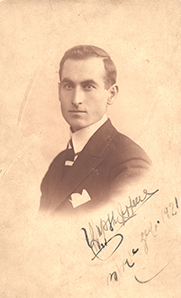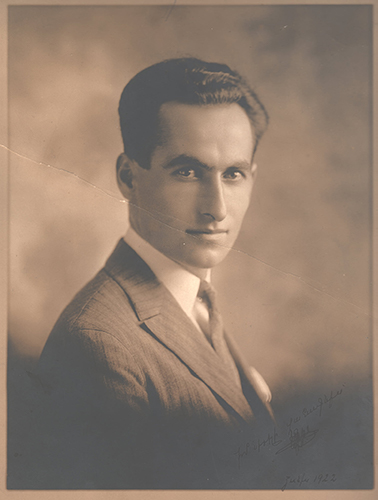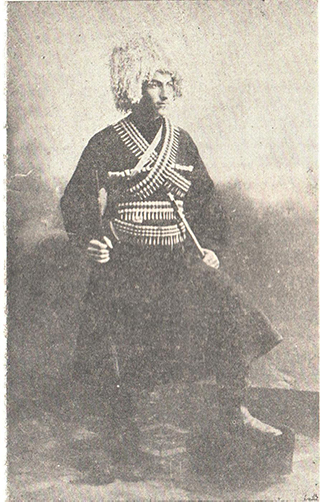15.03.2022

After the defeat of the Ottoman Empire in World War I, its new government decided, under pressure from the Allies, to prosecute members of the Young Turk government and the central committee of the Union և Progress Party for dragging the Ottoman Empire into the war and organising the deportation and massacre of the Armenians. The main group of culpable Young Turks (Mehmet Talat, Ismail Enver, Ahmed Cemal, Behaeddin Shakir, Mehmet Nazim, Osman Bedri and Hussein Azmi) had, however, already escaped responsibility and criminal arrest by leaving on a German warship on November 1, 1918.
In autumn 1919, the 9th general assembly of the Armenian Revolutionary Federation (ARF) in Yerevan, set up, in conditions of the strictest secrecy, a special mission (Hatuk Gortz) under the leadership of Armen Garo, (RA Ambassador to the United States), tasked with finding and suitably punishing the Young Turk organisers and perpetrators of the Armenian Genocide.
Soghomon Tehlirian (1896-1960) is rightly considered to be the most famous figure in the special operational group (operation “Nemesis”) and may be considered as a symbol of Armenian revenge. This is due not only to the fact that his target was that most famous criminal, Talat, but also because his trial was widely publicised. Before joining the special operations group, Tehlirian, despite his young age, had a rich military career, having been a comrade-in-arms of prominent figures in the national liberation struggle such as General Andranik, Murad of Sebastia (Sebastaci Murad), Kaydzak Arakel, Sepuh and others.
The idea of targeting and annihilating Talat as the main organiser of the massacres of Armenians was born in Tehlirian in 1916 when, as a young volunteer, entering his home town of Yerznka (Erzurum vilayet) with his comrades-in-arms, he saw his parental home emptied, looted and turned into a ruin. Seeing it, he lost consciousness, due to severe mental stress and had a vision of his murdered mother.
Soghomon Tehlirian did not know Talat personally, met him face to face or spoke German. A professional team, which had already done a great deal of reconnaissance and organisational work, was waiting him in Berlin to help him carry out the mission entrusted to him.
Talat had changed his personal details in Berlin, living with his wife under the new name of Ali Salih Bey in a luxurious nine-room rented apartment on Hardenberg Street. According to legend, Ali Salih was a bankrupt former merchant who ran an oriental cafe in Berlin. The apartment had been rented for him and his wife by the Turkish embassy. Talat had also changed his appearance and wearing a European hat instead of his favourite Turkish fez. The search for Talat was directed from Boston, from where coded telegrams were regularly sent. Tehlirian managed to rent an apartment near Talat’s and followed him closely for several days.
Talat was revealed. His identity was thoroughly verified, as it was important that no one should be accidentally harmed during the operation. His execution took place on March 15, 1921, the day before the signing of the Moscow Anti-Armenian Treaty. The day of the execution was not chosen at random, as the Moscow Russo-Turkish conference (February 26-March 16, 1921), which resulted in the Treaty of “Friendship and Brotherhood”, between the Bolsheviks and the Kemalists, decided the issue of Armenian territories without the participation of the Armenian side. That morning, Tehlirian assassinated Talat Pasha, the main perpetrator of the Armenian Genocide, on Berlin’s Hardenberg Street. Only he knew, at that time, that the executed person was Talat.
Tehlirian was arrested at the scene of the murder and taken to the local police station, where the interrogation began. As he spoke almost no German, he was offered interrogation, as a Turkish citizen, in Turkish. At Tehlirian’s request, however, the interrogation was conducted in Armenian using an Armenian translator. He insisted that he had killed Talat out of revenge, had acted alone and had no accomplices.
“Ali Salih’s” body was identified by his old friend Behaeddin Shakir, who confirmed that the victim was former Turkish Grand Vizier Talat. Talat was buried only on the 5th day after his death as the Turkish authorities forbade his burial in his homeland. Turkey’s former allies, the Germans, organized Talat’s lavish funeral in Berlin; with numerous wreaths, Turks arriving from different countries, anti-Armenian speeches and citations….
During the trial (Berlin, June 2/3, 1921), a high-ranking German officer, Liman von Sanders, the well-known pro-Armenian public figure Johannes Lepsius and Armenian Genocide survivors all testified. Tehlirian was defended by prominent lawyers Adolf von Gorton who was a confidential legal adviser, Johannes Werthauer, a legal adviser, and Dr. Kurt Niemeyer, a professor of law at Kiel University. His lawyers used original telegrams to substantiate Talat’s crime, in which the former Minister of Internal Affairs of Turkey gave the orders for the deportation and extermination of the Armenians.
In legal terms, Tehlirian’s defence was based on Article 51 of the German Criminal Code, which provided: “There is no punishable act if the perpetrator was unconscious at the time of the act or has a pathological disorder of mental activity, due to which his will is excluded.” S. Tehlirian was released, by the decision of the jury, on June 3, 1921.
S. Tehlirian's trial had a great social-political response. It was widely covered by the European, American and Armenian press of the time, as well as by German and Turkish journalists.
After the trial, S. Tehlirian first settled in Manchester, then in Belgrade (Serbia) as Sogomon Melikian. He had his own business. Changing his name was related to his and his family’s safety. He moved to Casablanca (Morocco) in 1953 and from there to San Francisco (USA) in 1954, where he died on May 23, 1960 as Soghomon Melikian. His body was buried in Fresno.
Married to Anahit Tatikyan, he had 2 sons, Zaven and Shahen.
Gohar Khanumyan
AGMI Chief registrar

Soghomon Tehliryan, June 1922
Ara Oskanyan family archive

Soghomon Tehliryan, volunteer, Yerevan 1915
(Soghomon Tehliryan, Recollections, (Assassination of Talat). Transcribed by Vahan Minakhoryan, Cairo, 1953))

Soghomon Tehliryan’s trial, 1921
(Soghomon Tehliryan, Recollections, (Assassination of Talat). Transcribed by Vahan Minakhoryan, Cairo, 1953))

Talat Pasha, Minister of the Interior of the Ottoman Empire
Armenian Genocide Museum-Institute





